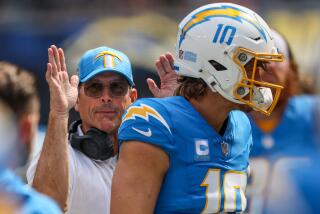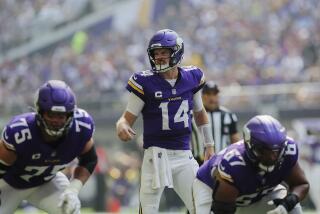SUPER BOWL XXV / NEW YORK GIANTS 20, BUFFALO BILLS 19 : Bills Are Confounded by No-Muddle Offense
- Share via
TAMPA, Fla. — You ever see a guy win a poker hand against three aces with a pair of treys? You ever see a .220 hitter work a Hall of Fame fastball pitcher for a walk to win a game? Like to see a tennis player whose specialty is just getting the ball back win in straight sets over a major league serve-and-volleyer?
Talk about winning ugly!
Listen! For the information of the Buffalo Bills football team, the football is an oblate spheroid about 11 inches long and six in diameter and leather covered.
They didn’t get to see it much Sunday night in Super Bowl XXV.
That’s why they lost the football game.
It was a magnificent job of doing a lot with a little. The Buffalo Bills came into the game with the reputation as the New York Yankees--1927 version, that is--of football. They had an all-world quarterback, an all-universe defensive end. They were younger, quicker, gaudier. A power lineup. Home run hitters. They knew they weren’t going to get the ball much. They didn’t think they were going to need it much.
They almost didn’t get it at all.
The Giants had a backup quarterback, one overage running back in Ottis Anderson, and one undersized running back in Dave Meggett. They were a little long in the tooth, i.e. Lawrence Taylor. They knew they couldn’t get in a slugging match with the Buffaloes, couldn’t go toe-to-toe. They had to win on clinches, nifty footwork and infighting.
They knew that if Buffalo’s Jim Kelly got the ball, they were in big trouble. Their game plan was to keep it from him. The first time they got the ball, they used 6 minutes and 15 seconds to score three points.
Buffalo came right back and scored three points in 1:23.
In the third quarter, with the Bills leading, 12-10, the Giants used 9:29 to score the go-ahead touchdown. The drive was 75 yards. That’s what? Eight yards a minute?
That’s major league hogging the ball. That’s taking the ball out like a dog with a bone and burying it in the back yard.
It was masterful strategy. It was like watching a guy with no punch, legs gone, arms weary, smothering the other guy like an octopus.
You get 45 seconds to put the ball in play in the NFL. The Giants used 44 on every play. The Buffalo Bills used the ho-huddle offense. So they could get a lot of plays off. In mini-seconds.
But to get a lot of plays off, first you need the ball. On the rare occasions that the Giants, grudgingly, had to hand the ball over to the Bills, Buffalo’s quarterback Kelly kept throwing these haymakers. He over-bet his hand. If it had been a cartoon, the Giants would have been Bugs Bunny and the Bills Elmer Fudd.
“It was not an easy job to do,” Giant linebacker Carl Banks confided. “These guys had blinding speed. We didn’t roll over teams. We do it step by step.”
The Giants roll up yards like a guy laying brick. They finally put the game right where they wanted it. They had the lead, 20-19, and put the Bills on their own 10-yard line with 2:16 to play.
Then they did what a lot of teams do in that situation: They peeled back frantically when Kelly got the ball and cocked his arm. Instead of passing, though, Kelly either ran the ball himself or handed it off to a running back. All of a sudden, with only two passes in the drive, for gains of four and six yards, the Bills were on the Giants’ 29-yard line and in field goal range.
Or, rather, not in field goal range. At least, not quite Scott Norwood’s.
The official most valuable player of the game was the venerable Anderson. Second in the running was Jeff Hostetler, the backup quarterback turned starter.
But it was hard to overlook the tight end, Mark Bavaro.
On the Giants’ game-winning drive--which took the usual 7:32 to effect--there were three key catches by Bavaro--one for 16 yards, one for 20, one for one to the nine.
People knew Bavaro could catch. This was the Super Bowl when people found out he could talk.
Mark Bavaro was, for Notre Dame, quite a specimen. Notre Dame is the school that gave the world the wise-cracking Knute Rockne, the master after-dinner speakers, the Four Horsemen and the loquacious Joe Theismann. It’s a school that prides itself on fast-talking, breezy athletes who like to be noticed. The school encourages its football players to become more like Theismann, comfortable on podiums, visible at school functions, not exactly the life of the party but not monks or tongue-tied recluses either.
Bavaro broke the mold. Bavaro became more like the campus Garbo. When innocent journalists wandered into Giant locker rooms on the road, the veteran Giant writers used to gather to watch the fun. Bavaro would just fix his inquisitor with a wide-eyed stare. And dead silence. The unwary writer would think Bavaro had a hearing problem. He didn’t.
When the Giants made the Super Bowl in 1987, Bavaro showed up for the first press day, posed for photos--then went out and sat in the team bus, closed the door and stared stonily ahead when the desperate scribes beat on the windows and begged for a colloquy with the star tight end.
Bavaro didn’t exactly turn into Ronald Reagan. He is still a man of few words. But he is no longer a man of no words.
That’s because Mark Bavaro has found a mission. He is one of the more passionate right-to-life advocates. His interviews veered from football (he blocks the outside linebacker on running plays, takes the middle route on passing plays) to the philosophical. He is opposed to abortion and used his Super Bowl platform to espouse his point of view.
Why was he interesting himself in such a controversial issue--in front of people who really wanted to know what his stand was on the down-and-out or the post pattern?
“I have very high standards, very high values,” Bavaro said carefully. “I’m a practicing Catholic and I am joining many Catholics and Protestants and Jews in opposing abortion. I am a Catholic for life and mean to use the influence of this platform to get our message across. It’s not a mission, it’s a matter of life or death.”
Mark Anthony Bavaro was a key player in the Giants’ steal of Super Bowl XXV. The team’s second-leading receiver during the season, he and Mark Ingram were the leading receivers in Sunday’s Super Bowl with five catches each.
Tree-tall and possessed of only moderate speed, he caught three passes in the forth-quarter drive that set up the game-winning field goal. He symbolizes the Giants, an overachiever who can take what skills he has and husband them to get the job done over the more gifted.
I think it was Grantland Rice who once said, “The race is not always to the swift, nor the victory to the strong--but that’s the way to bet.”
Well, this was one time it was not the way to bet. The Giants didn’t win the game with mirrors. They stole it with consummate patience, resilience and a refusal to be stampeded.
The tortoise beat the hare again. Scott Norwood’s kick didn’t lose the game for his team. It shouldn’t have been necessary. His team lost because they had the ball for only 19 of the 60 minutes. The tortoises had it for more than 40 minutes.
It’s always tough to beat the dealer. It’s hard to get lucky if you never get the dice. It’s tough to win if you never get to bat. The Giants should at least send them the ball to look at.
Along with a note: “This is a football--try and get it.”
More to Read
Go beyond the scoreboard
Get the latest on L.A.'s teams in the daily Sports Report newsletter.
You may occasionally receive promotional content from the Los Angeles Times.










